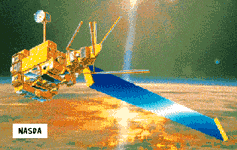ADEOS
Advanced Earth Observation Satellite
 The polar orbiting ADEOS spacecraft will perform Earth, atmospheric, and oceanographic remote sensing. ADEOS 1 and 2 use the same bus design to fly different instrument suites. These are the largest satellites Japan has ever developed. Several of the instruments on ADEOS were provided by NASA, NOAA, and CNES. The launch of ADEOS 2 is planned for early 1999.
The polar orbiting ADEOS spacecraft will perform Earth, atmospheric, and oceanographic remote sensing. ADEOS 1 and 2 use the same bus design to fly different instrument suites. These are the largest satellites Japan has ever developed. Several of the instruments on ADEOS were provided by NASA, NOAA, and CNES. The launch of ADEOS 2 is planned for early 1999.
Spacecraft
3-Axis stabilized, zero momentum biased control system with 0.3 deg control and 0.003 deg/sec stability using reaction wheels. Single solar array generates 4.5 kW for a 34 to 52 volt floating bus with 5x35 AHr NiCd batteries. Hydrazine propulsion system (135 kg fuel) for orbit maintenance. S-Band TT&C (S-Band, Uplink: 500 bps, Downlink: 4 Mbps). Ka-Band data crosslink at 120 Mbps to COMETS. X-Band direct downlink (40W and 8W, QPSK). System reliability is 0.7 at 3 years.
Payload
ADEOS-1 Payload Description: AVNIR (Advanced Visible and Near-Infrared Radiometer): five visible/near-infrared bands (0.42 to 0.89 Ám); 16- or 8-m resolution; 80 km swath; +/- 40 deg cross-track pointing; stereo capability (from NASDA). ILAS (Infrared Limb Atmospheric Spectrometer): infrared occultation device (from Japan's Environmental Agency). IMG: nadir-looking Fourier transform infrared spectrometer (from
MITI). NSCAT: active Ku-band scatterometer (from NASA). OCTS: Ocean Color Temperature Scanner (from NASDA). POLDER: (from CNES). RIS: (from Japan's Environmental agency). TOMS: Total Ozone Mapping Spectrometer (from NASA).
ADEOS-2 Payload Description: AMSR (Advanced Microwave Scanning Radiometer), GLI (Global Imager), Sea Winds, POLDER
(Polarization and Directionality of the Earth's Reflectances), ILAS-II (Improved Limb Atmospheric Spectrometer-II)
| Country of Origin | Japan |
| Customer/User | NASDA |
| Manufacturer(s) | Mitsubishi Electric Co. (MELCO) |
| Size | 4 x 4 x 5 m bus with 3 x 26 m solar array |
| Orbit | LEO, 797 km, sun-synchronous polar with 10:30 equatorial crossing, with a 41 day repeating ground track. (98.6 deg inclination). ADEOS-2 will have a 4 day repeat orbit. |
| Design Life | 3 years |
| Related Sites | NASDA ADEOS Page |
Launch Facts
| Name | Int'l Desig. | Date | Site | Vehicle | Orbit | Mass(kg) |
| Notes | ||||||
| ADEOS 1 (Midori) | 1996-046A | 8/17/96 | Tanegashima | H-2 | LEO | 3500 |
| ADvanced Earth Observation Satellite; ocean wind and temperature monitoring, atmospheric gas monitoring; payload includes instruments from NASA, NOAA, CNES | ||||||
Information in The Mission and Spacecraft Library is provided without warranty or guarantee. USE AT YOUR OWN RISK.